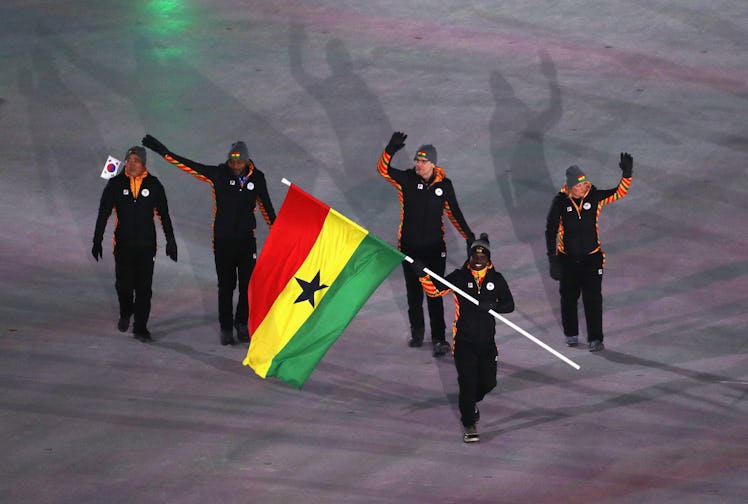
Here's Why The Countries Are Being Announced "Out Of Order" At The Opening Ceremony
The 2018 Winter Olympics opening ceremony on Friday, Feb. 9 follows many traditions, and one of them includes a specific order in which the countries march with their respective flags. At first, it may seem like some countries are misplaced, but there is a method to the madness. Once you understand the reasoning behind it, the order of countries at the 2018 Olympics opening ceremony makes total sense.
For English speakers who are familiar with alphabetical order, a quick glance at the 2018 PyeongChang Olympics opening ceremony marching order on for the participating countries is puzzling. For reference, Albania marched well after Team USA. To make sense of it all, you need to stop trying to make it work according to the English language.
It's all about the host country when it comes to the Olympics, and this year that honor goes to South Korea. With that, the order of the countries goes in alphabetical order as they're spelled in the Korean language. The host country's language is used to alphabetize the marching order in every Olympic opening ceremony, according to USA Today.
There is an exception, though, when it comes to Greece's spot in the order. Since Greece is the birthplace of the modern Olympic Games, they have the honor of marching first every time (being the OG of the Olympics has it's perks).
Another exception to the alphabetical mandate in the host country's language involves the host country itself. Olympic tradition calls for the host country to march last. So, South Korea and North Korea (who marched together) closed out the order.
When put into Korean alphabetical order, the opening ceremony began with Greece (because OG rules), and then the crowd saw Ghana, Nigeria (who made their Winter Olympics debut), South Africa, and Netherlands as the first five countries.
In total, 92 nations marched in the 2018 PyeongChang opening ceremony, but you might have noticed a couple oddities regarding the flags as there were only 91 of them. First, since Russia was banned from the Winter Olympics because of their 2014 doping scandal in Sochi, the Olympic Athletes from Russia who were cleared to compete marched under the International Olympic Committee (IOC) flag (not the Russian flag) right after Austria.
Finally, South Korea and North Korea marched together as one Korea under the Korea Unification Flag. While South Korea and North Korea will compete separately during the Winter Olympics, they will also compete together on a joint women's hockey team, according to NBC. These unifying efforts hope to somewhat ease the tensions between these two countries during the Winter Olympics and hopefully beyond.
As you watched the countries march in the PyeongChang Olympic Stadium in Korean alphabetical order, you likely noticed different crowd sizes among the national teams. The largest number of athletes was the 242 Olympians on Team USA, followed by 226 Canadian Olympic athletes, and 171 Olympic athletes competing for Switzerland.
If you have better than average knowledge of the history of the Olympic Games, you probably noticed that there are some newcomers to the Winter Olympics this year. In fact, six countries are making their Winter Olympics debut this year in PyeongChang. Joining Nigeria in their inaugural Winter Olympics are Ecuador, Eritrea, Kosovo, Malaysia, and Singapore.
Even if you were initially confused by the marching order of the competing nations of this Winter Olympics, you probably still managed to notice all of the smiles on the faces of the athletes marching for their countries. Whether the Olympians were new to the Winter Olympics or have competed before, it was clear that all of them were very proud to represent their country during the opening ceremony — wherever they landed in the marching order.